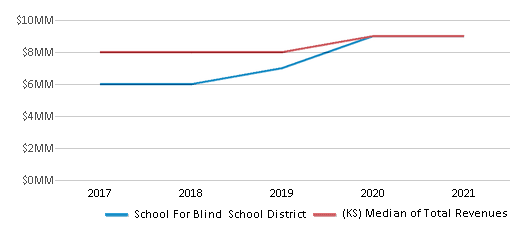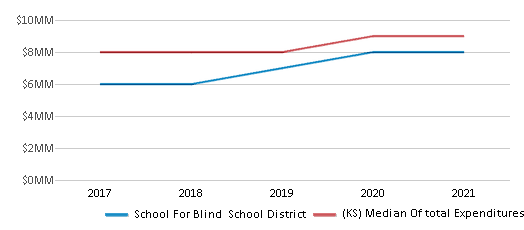Top Rankings
School For Blind School District ranks among the top 20% of public school district in Kansas for:
Category
Attribute
Diversity
Most diverse schools (Top 1%)
Student Attention
Lowest student:teacher ratio (Top 1%)
For the 2025 school year, there are 2 public schools serving 18 students in School For Blind School District.
Public Schools in School For Blind School District have a diversity score of 0.68, which is more than the Kansas public school average of 0.57.
Minority enrollment is 50% of the student body (majority Hispanic), which is more than the Kansas public school average of 39% (majority Hispanic).
Overview
This School District
This State (KS)
# Schools
2 Schools
1,340 Schools
# Students
18 Students
477,627 Students
# Teachers
13 Teachers
33,417 Teachers
Student : Teacher Ratio
1:1
1:1
Students by Ethnicity:
Diversity Score
0.68
0.57
# American Indian Students
n/a
3,553 Students
% American Indian Students
n/a
1%
# Asian Students
1 Student
13,530 Students
% Asian Students
6%
3%
# Hispanic Students
4 Students
104,522 Students
% Hispanic Students
22%
22%
# Black Students
2 Students
31,245 Students
% Black Students
11%
7%
# White Students
9 Students
293,371 Students
% White Students
50%
61%
# Hawaiian Students
n/a
1,139 Students
% Hawaiian Students
n/a
n/a
# Two or more races Students
2 Students
30,267 Students
% of Two or more races Students
11%
6%
Students by Grade:
# Students in PK Grade:
-
21,787
# Students in K Grade:
-
31,674
# Students in 1st Grade:
1
32,919
# Students in 2nd Grade:
1
34,119
# Students in 3rd Grade:
3
33,302
# Students in 4th Grade:
2
34,287
# Students in 5th Grade:
-
34,416
# Students in 6th Grade:
-
35,078
# Students in 7th Grade:
2
35,096
# Students in 8th Grade:
3
36,357
# Students in 9th Grade:
1
37,517
# Students in 10th Grade:
1
37,330
# Students in 11th Grade:
4
36,547
# Students in 12th Grade:
-
34,737
# Ungraded Students:
-
2,461
District Revenue and Spending
Total Revenue
$9 MM
$7,774 MM

Spending
$9 MM
$8,211 MM

Best School For Blind School District Public Schools (2025)
School
(Math and Reading Proficiency)
(Math and Reading Proficiency)
Location
Grades
Students
Rank: n/an/a
School For Blind Elementary School
Special Education School
1100 State Avenue
Kansas City, KS 66102
(913) 305-3000
Kansas City, KS 66102
(913) 305-3000
Grades: PK-6
| 7 students
Rank: n/an/a
School For Blind High School
Special Education School
1100 State Avenue
Kansas City, KS 66102
(913) 305-3000
Kansas City, KS 66102
(913) 305-3000
Grades: 7-12
| 11 students
Frequently Asked Questions
How many schools belong to School For Blind School District?
School For Blind School District manages 2 public schools serving 18 students.
What is the racial composition of students in School For Blind School District?
50% of School For Blind School District students are White, 22% of students are Hispanic, 11% of students are Black, 11% of students are Two or more races, and 6% of students are Asian.
What is the student/teacher ratio of School For Blind School District?
School For Blind School District has a student/teacher ratio of 1:1, which is lower than the Kansas state average of 14:1.
Recent Articles

Year-Round Or Traditional Schedule?
Which is more appropriate for your child? A year-round attendance schedule or traditional schedule? We look at the pros and cons.

Why You Should Encourage Your Child to Join a Sports Team
Participating in team sports has a great many benefits for children, there is no doubt. In this article you will learn what those benefits are.

White Students are Now the Minority in U.S. Public Schools
Increasing birth rates among immigrant families from Asia and Central and South America, combined with lower birth rates among white families, means that for the first time in history, public school students in the United States are majority-minority. This shift in demographics poses difficulties for schools as they work to accommodate children of varying language abilities and socio-economic backgrounds.





